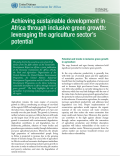Although evidence shows that women are both victims of climate change and important contributors of knowledge and skills in disaster risk, adaptation and mitigation strategies, the gender perspective is largely missing from the design and planning of climate change responses and policies. In addition, most research into gender and climate change has been exclusively conducted in rural contexts. There is strong scope for filling these knowledge gaps to improve the understanding of the relationship between gender and climate change in urban settings.
This policy brief explores the advantages and challenges of integrating a gender dimension into climate compatible development strategies in urban settings, with a focus on the Asian Cities Climate Change Resilience Network (ACCCRN) project in India. An initiative funded by The Rockefeller Foundation, the project was implemented in Gorakhpur, Uttar Pradesh by the Gorakhpur Environmental Action Group (GEAG).
Armenia and Georgia are taking the climate change agenda seriously and contributing to efforts for mitigating global climate change through various ways, including preparation of low-carbon development strategies for their future economic growth. The improvement of energy efficiency is one of the key elements of the low-carbon development strategies. This study develops a methodology to estimate a marginal abatement cost curve for energy efficiency measures and applies it to the building sector in both countries. The study finds that among the various energy efficiency measures considered, the replacement of energy inefficient lightbulbs (incandescent lamps) with efficient lightbulbs is the most cost-effective measure in saving energy and reducing greenhouse gas emissions from the building sector. Most energy efficiency improvement options considered in the study would produce net economic benefits even if the value of reduced carbon is not taken into account.

This white paper provides an analysis of the Intended Nationally Determined Contributions (INDCs) for 37 partner countries in the U.S. Government's Enhancing Capacity for Low Emission Development Strategies (EC-LEDS) program and other designated priority countries. The white paper includes an overview of global INDCs, country profiles for countries, regional trends, and sectoral trends. Moreover, each country profile includes information from the INDC on the:


This policy brief is the second in a series of six briefs drawn from the fifth edition of the Sustainable Development Report on Africa, a joint publication of the Economic Commission for Africa (ECA), the Food and Agriculture Organization of the United Nations, the United Nations nvironmentProgramme, the United Nations Industrial Development Organization and the United Nations Development Programme on the theme “achieving sustainable development in Africa through inclusive green growth”. The brief highlights the role of agriculture in promoting inclusive green growth in the region.
Implementing inclusive green growth interventions in subsectors of agriculture including the crop, agro forestry and livestrock will bring value addition by enchaing productivity and increasing household revenue while reducing vulnerability to the growing threats of climate change. The report provides best practices from various subsector and summarises lessons learned.
